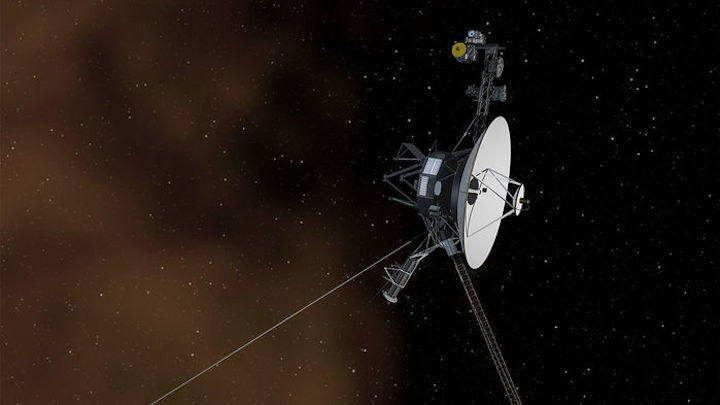10.01.2019

An illustration of Voyager 1, now 21.7 billion kilometers away
JPL CALTECH/NASA
Humanity’s most far-flung spacecraft, NASA’s 41-year-old Voyager 1, has poked a hole in a long-shot theory of dark matter. Some theorists have argued that the mysterious, unseen stuff, which makes up 85% of the universe’s matter, could consist of countless black holes lingering from the big bang. But Voyager 1, which launched in 1977 and slipped out of the solar system 6 years ago, sees no signs of such hordes, a pair of theoretical physicists reports. The data don’t kill the idea that dark matter is black holes entirely, however, as Voyager 1 can detect only tiny black holes.
“I never thought we’d be able to contribute in any way to studying dark matter,” says Alan Cummings, a space scientist at the California Institute of Technology in Pasadena who has worked on Voyager 1 since 1973 and who was not involved in the analysis. “That’s great!”
For decades, astrophysicists have thought some sort of unseen matter provides the gravity needed to hold galaxies like our Milky Way together. For nearly as long, some scientists have speculated that dark matter might consist of black holes, knots of ultraintense gravitational fields typically created when massive stars collapse under their own weight to infinitesimal points.
But making black holes work as dark matter is tricky. In the universe, dark matter outweighs ordinary matter six to one, and there can’t have been enough collapsing stars to produce that lopsided ratio. So the black holes would have had to arise in a different way, through the collapse of tiny fluctuations in the soup of fundamental particles that filled the newborn universe long before stars formed. Such primordial black holes could have nearly any mass, but they cannot be too abundant without running afoul of astronomical observations. For example, throngs of black holes much more massive than the sun would shred galaxies like cannon balls crashing through chandeliers. Hordes of smaller black holes should distort the images of more distant stars and galaxy through so-called gravitational lensing.
Such observations leave just three possible mass ranges for primordial black holes, says Bernard Carr, a cosmologist at Queen Mary University of London, who has worked on the idea for 40 years. They could have masses between one and 10 times that of the sun; about one-billionth that of the sun; or below about a quadrillionth that of the sun—10 billion metric tons. Those smallest black holes would only be as wide as an atomic nucleus.
But if they’re there, the tiny black holes should produce a telltale radiation that Voyager 1 should see, argue Mathieu Boudaud and Marco Cirelli, theorists at Sorbonne University in Paris, in a paper in press at Physical Review Letters. Black holes earn their name because anything that gets too close to one, even light, cannot escape. However, in 1973, the late Stephen Hawking reasoned that black holes should radiate some light and particles nonetheless.
According to quantum mechanics, empty space roils with particle-antiparticle pairs flitting into and out of existence. Hawking realized that if such a pair pops into existence at just the right distance from a black hole then one particle might fall into the black hole while the other flies away in what is now called Hawking radiation. The smaller the black hole, the hotter it would be and the more it would radiate.
Tiny black holes weighing 10 billion metric tons should be hot enough to radiate electrons and positrons. Earth-bound detectors would not be able to spot those low-energy particles, as they would be deflected by the sun’s magnetic field. But Voyager 1 should be able to spot them from its position outside the sun’s magnetic bubble, the heliosphere.
In fact, since it exited the heliosphere in 2012, Voyager 1 has measured a small, consistent flux of positrons and electrons. But even if they all come from tiny black holes, there wouldn’t be enough black holes to account for more than 1% of the Milky Way’s dark matter, Boudaud and Cirelli calculate. Cummings says the energy spectrum of the particles suggests they all come from more mundane sources such as the remnants of supernova explosions.
The new work comes close to ruling out the lowest mass primordial black holes as dark matter, Carr says, although he adds that he has always favored the scenario in which the black holes weigh several solar masses. “This [low] mass window has never been my favorite,” he says. “It doesn’t personally bother me if the constraints now rule it out.”
Voyager 1 can’t search for the higher mass primordial black holes. They would be so heavy and cold that they could not radiate massive particles such as electrons and positrons. Instead, they would only shine an exceedingly feeble and likely undetectable light. So, for the moment, the idea of black hole dark matter lives on.
Quelle: Science
